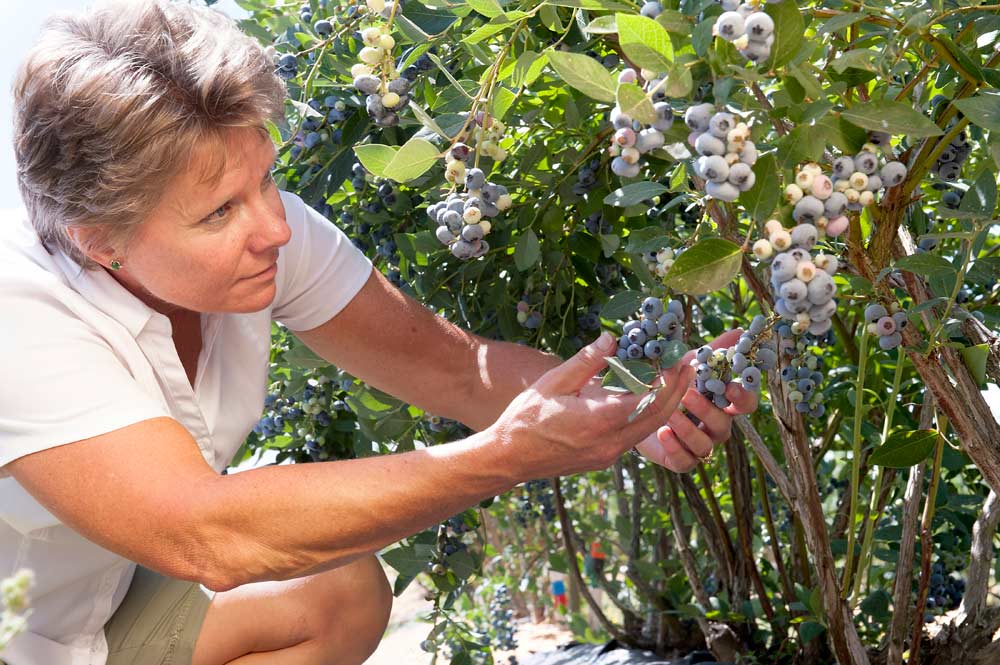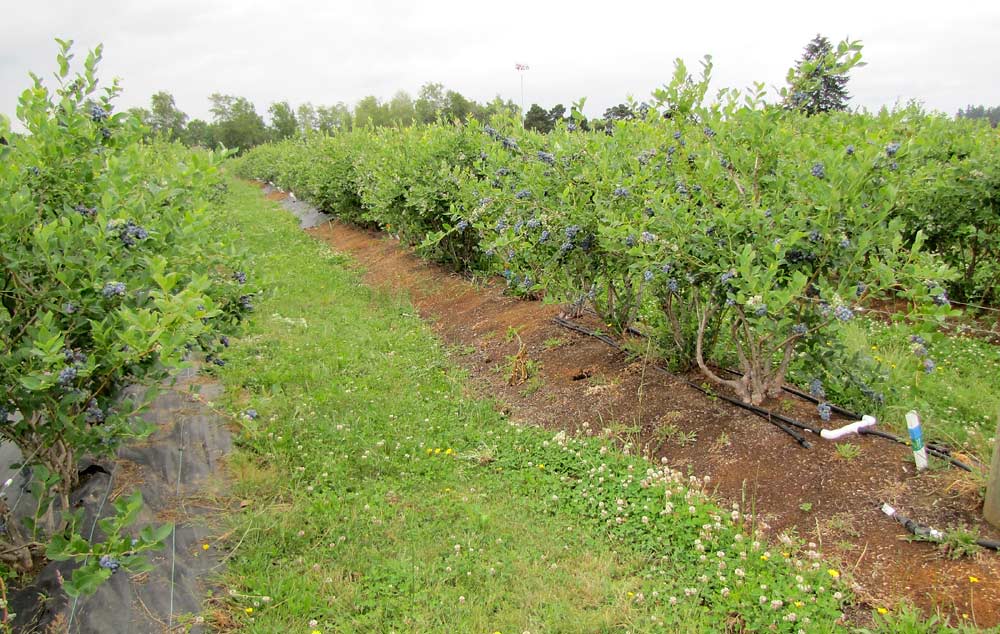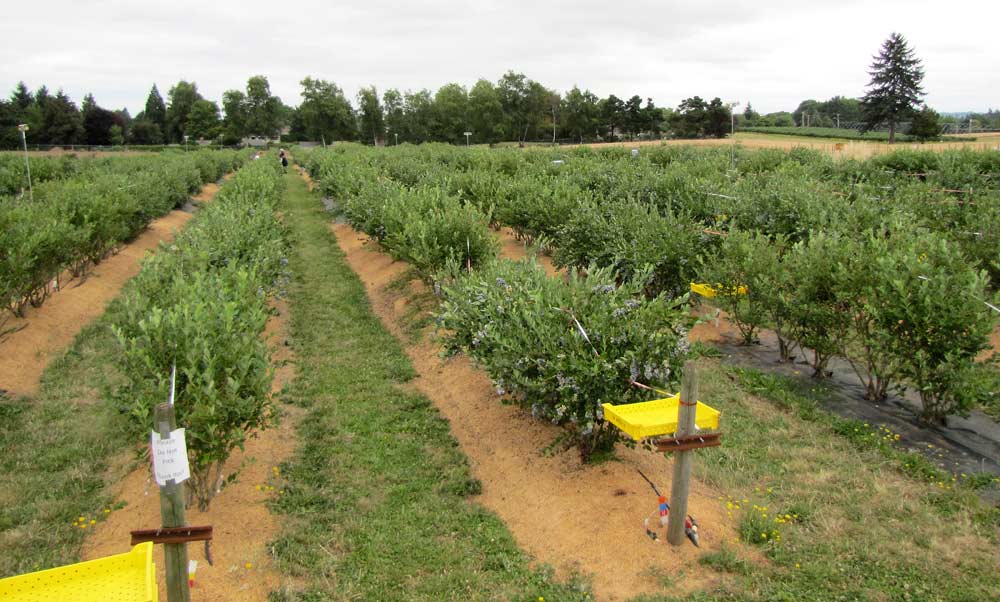
Bernadine Strik, Oregon State University Extension berry specialist, inspects organic blueberries in a test plot at OSU’s North Willamette Research and Extension Center in Aurora. Strik has completed a 10-year organic blueberry study published in September in the journal HortScience. (Courtesy Oregon State University)
Oregon State University researchers have finished and published an $890,000, 10-year study about the best ways to grow organic blueberries.
Not that growers have been waiting this whole time. They have been implementing the techniques for years as they learned through field days and presentations about the benefits of raised beds, feather meal fertilizer and weed mats.
“Growers will jump on things sometimes quickly,” said Bernandine Strik, lead researcher for the project, conducted on a one-acre block at OSU’s North Willamette Research and Extension Center.
Over the past 10 years as Strik made new findings, blueberry farms have been planting on raised beds, switching from sawdust mulch to weed mats, changing fertilizer products and cutting way back on nitrogen rates. Each year, she delivered reports to the Oregon Blueberry Commission and held field days. Grants from the Oregon Blueberry Commission, the Washington Blueberry Commission and federal agencies paid for the study.

Researchers determined weed mats, shown under the left row of organic blueberries in this June 2014 photo, led to better results and lower costs than compost as mulch in one aspect of the 10-year study. (Courtesy Oregon State University)
All the while, organic demand and production soared. When Strik started, organic accounted for about 2 percent of blueberry production in the United States. It’s now about 20 percent, and the Northwest produces about half the nation’s organic crop.
“There’s been a huge change in how organic blueberries are grown,” Strik said.
So, Strik’s completion of the project and publication in the September issue of HortScience felt almost anticlimactic, she said.
Almost.
“It’s nice to have it all kind of complete in one write-up,” said T.J. Hafner, lead agronomist for AgriCare, a company that manages 2,000 acres of organic or transitioning blueberries throughout Oregon.
His staff has made several changes in horticultural practices based on Strik’s research over the years. They use feather meal and plant based liquids instead of fish emulsion. They have cut back on the rate of nitrogen per her findings. And nearly everybody who plants a new blueberry patch these days uses raised beds and weed fabric now, he said.
“Absolutely, it’s because of her research,” said Hafner, also the chair of the Oregon Blueberry Commission’s research committee.
One large organic grower told Strik his plants nearly doubled in size after he took her suggestion of cutting his fish fertilizer rate by two-thirds, not to mention he saved money. Turns out the industry fertilizing standard rate was way too high.
“That was adopted almost immediately,” she said.
In fact, some of the techniques, such as raised beds and weed mats, were starting to catch on with growers even before she started, which is one of the reasons in 2006 the Oregon Blueberry Commission asked her to put together a project, she said. Noticing the increasing demand for organic produce, commissioners mostly wanted Strik to determine if growers could make organic blueberries pencil out. She says the answer is a resounding yes.
In October 2006, she planted her one-acre block of Duke and Liberty blueberries, comparing the effect of several horticultural practices on yield, fruit quality and cost, including labor, to the point of painstakingly documenting each hour she and her staff spent pulling weeds by hand. She even went through the process of certifying her organic plantings and selling commercial market, just to jump through all the hoops and hurdles growers would.
Now, she’s going back for more.
She has secured more funding to explore a few more topics.
Weed mats have advantages over sawdust mulch, but they also have drawbacks such as raising the soil temperature, causing quicker breakdown of organic matter, providing shelter to pesky voles and increasing irrigation needs. Meanwhile, fish emulsion is high in potassium, maybe too much for blueberries. Too much potassium can disrupt a plant’s ability to take up calcium or magnesium.
She is looking for ways to mitigate these problems, as well as experiment with different weed mat colors and spreading a layer of sawdust under the weed mats. •
Organic blueberry study findings

The study results also measured the effectiveness and cost of sawdust as mulch and the difference between raised beds and flat plantings. (Courtesy Oregon State University)
Here are a few key results of a 10-year, $890,000 study of organic blueberry production practices by Oregon State University, led by Bernadine Strik, a berry crops professor.
—Using weed mats as opposed to sawdust mulch or a combination of yard debris compost and sawdust led to a 6 percent increase in yield, no difference in fruit quality and between 35 percent and 50 percent lower weed control costs per acre, including labor and products. Sawdust mulch was the industry standard before the study.
—The weed mat increased irrigation needs by about 50 percent, boosted soil temperatures, broke down organic faster and provided shelter for rodents.
—Feather meal fertilizer was half the cost per acre as fish emulsion, the organic industry standard before the study.
—The study involved Duke and Liberty varieties. Duke yielded 35 percent less with fish emulsion than feather meal. Liberty had the same yield with both fertilizers.
—On Duke, less was more when it came to nitrogen. The industry standard was 50 pounds per acre on young plants and 130 pounds per acre on mature plants. Cutting those in half led to 4 percent higher yields. Liberty had the same yields regardless of rate.
—The type of fertilizer or rate did not affect fruit quality in either variety.
—Raised beds boosted yields by 22 percent over flat ground, outweighing any benefit flat beds would provide in weed control, Strik said. Flat ground is easier to mechanize than contoured ground.
—Growing in raised beds with sawdust mulch and high rates of fish emulsion yielded 4-6 tons per acre. Using weed mats and lower rates of feather meal boosted yields to 5-9 tons per acre.
—by Ross Courtney






Leave A Comment